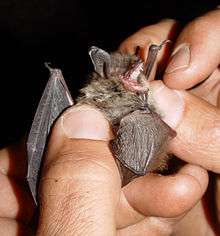Whiskered bat
The whiskered bat (Myotis mystacinus) and related species, are small European bats with long fur. Although uncommon, M. mystacinus is often found around human habitation and around water; it is similar to Brandt's bat Myotis brandtii, from which it was distinguished as a separate species only in 1970.
| Whiskered bat | |
|---|---|
 | |
| Scientific classification | |
| Kingdom: | Animalia |
| Phylum: | Chordata |
| Class: | Mammalia |
| Order: | Chiroptera |
| Family: | Vespertilionidae |
| Genus: | Myotis |
| Species: | M. mystacinus |
| Binomial name | |
| Myotis mystacinus (Kuhl, 1817) | |
 | |
Overview
The analysis of morphological, behavioural, and especially genetic characters have since identified further cryptic species of whiskered bats in the genus Myotis, including Myotis alcathoe (described in 2001 from Europe). Myotis aurascens and Myotis ikonnikovi are other similar species [2]. Myotis hajastanicus was also included in M. mystacinus until recently, but it was differentiated on the base of morphologic comparison.[1]
Echolocation
The frequencies used by M. mystacinus for echolocation are 34–102 kHz, have most energy at 53 kHz, and have an average duration of 3.0 ms.[3][4]
References
- Coroiu, I. (2016). "Myotis mystacinus". The IUCN Red List of Threatened Species. 2016: e.T14134A22052250. doi:10.2305/IUCN.UK.2016-2.RLTS.T14134A22052250.en.
- "Myotis aurascens", Science for Nature Foundation
- Parsons, S. and Jones, G. (2000) 'Acoustic identification of twelve species of echolocating bat by discriminant function analysis and artificial neural networks.' J Exp Biol., 203: 2641-2656.
- Obrist, M.K., Boesch, R. and Flückiger, P.F. (2004) 'Variability in echolocation call design of 26 Swiss bat species: Consequences, limits and options for automated field identification with a synergic pattern recognition approach.' Mammalia., 68 (4): 307-32.
